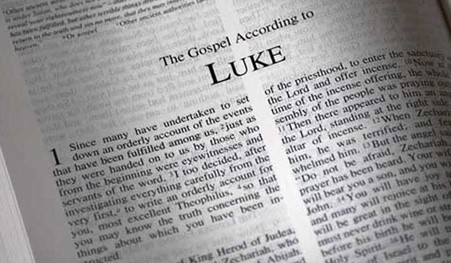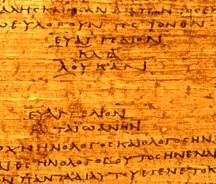We don’t have “signed autograph copies” of any book in the NT. So what we say about authorship needs to be deduced, from what is in each book, and what is said about the books in the earliest literature.
The indications about authorship from within each book need to be seen as most important. The claims made about authorship in the later traditions have a secondary significance.
Tradition has it that the authors of the four Gospels were men. This depiction, like so many others, portrays them as mature aged and bearded—but the Gospels were most likely first written on papyri scrolls, rather than bound codices (which are like a modern book).
None of the Gospels identify a specific, named individual as their author. The closest we come is in the two Gospels usually considered to be the later works written: Luke, and John. But first, let’s consider the earlier works: Mark, and Matthew. There are some deductions that have been made from within these two Gospels about who wrote them.
The author of Matthew’s Gospel is often assumed to be “a man called Matthew sitting at the tax booth” (Matt 9:9) whom Jesus called to follow him. In Mark and Luke, this person is named Levi; some interpreters consider that the fact that he is named Matthew in the first Gospel is a pointer to the author. But the text itself does not make this explicit claim anywhere.
The Gospel begins with what looks like a title: a book of origins of Jesus, chosen one, son of a David, son of Abraham (my translation of Matt 1:1), but gives no indication at any point as to who has compiled this book of origins.
Calling the author “Matthew” is thus a convention from later tradition.
The author of Mark’s Gospel is sometimes claimed to be “a certain young man … wearing nothing but a linen cloth” (Mark 14:51), as this is the only Gospel that refers to this person; but yet again, there is no explicit claim anywhere in the text that this is the man who wrote the Gospel.
Nor is there any warrant for connecting the author of this Gospel with John Mark, the companion of Paul and Barnabas (Acts 12:25, 13:5, 13, 15:37) and son of the Mary who lived in Jerusalem (Acts 12:12). There is nothing in the text of the earliest Gospel that points to this identification.
This Gospel also begins with what looks like a title: the beginning of the good news of Jesus, chosen one, son of God (my translation of Mark 1:1), but, like Matthew, there is no indication at any place in the text as to who has compiled this narrative.
Calling the author “Mark” is also a convention from later tradition.
The Gospel of John concludes with the claim, “this is the disciple who is testifying to these things and has written them” (John 21:24). This comes immediately after an account of an interaction between Peter and “the disciple whom Jesus loved” (John 21:20-23).
The figure of the beloved disciple appears in the Gospel four times: at the last supper (13:23), at the foot of the cross as Jesus is crucified (19:26), at the beginning of the empty tomb scene (20:2), and beside the Sea of Tiberias, after the resurrection of Jesus, along with other disciples (21:7).
A classic medieval depiction of “the disciple whom Jesus loved”, resting on his chest in a pose of intimacy (as per John 13:23 and 21:20). Of course, an authentic depiction would have shown the group reclining right around a low table, not sitting on one side of a raised table.
Yet “the disciple whom Jesus loved” is never identified by any personal name. Indeed, there is never an explicit claim that is made anywhere in the text that “the disciple whom Jesus loved” was, in fact, the apostle John. The Gospel may infer this, but it never states it.
Alongside that, there is the curious fact that whenever the name John appears in this Gospel, it never refers to John the apostle. (The named apostles in this Gospel have some overlap with the names of the Twelve in the Synoptic Gospels, but John is not named amongst those men in this Gospel.) Indeed the name John in the fourth Gospel refers either to John the baptiser (1:6, 15, 19-40; 3:22-30; 4:1; 5:33; 10:40-41) or to the father of Simon Peter (1:42; 21:15-17).
And there are many scholars who believe that John 21 was a much later addition to the original version of John’s Gospel (John 1—20). So it is most likely that this authorial claim was not actually written by the person who wrote the vast majority of the Gospel!
A chapter before this addition, at John 20:30-31, there is an explanation as to the purpose of this work: “Jesus did many other signs … but these (signs) were written in order that you may believe …”. From this, I deduce that this work intended to present itself as a book shaped around a number of signs: the book of signs, I call it.
Calling the author “John” is thus a convention from later tradition, made on the basis of the observations and deductions noted above.
The Gospel of Luke begins with a personal statement by the anonymous author: “I decided … to write an orderly account for you, most excellent Theophilus” (Luke 1:3). No indication is given by the author as to his (or her) identity. The only name here—ironically—is of the recipient of the work, “most excellent Theophilus”.
We don’t know anything about who Theophilus was, as an historical person, let alone who the “I” actually was. All we have is that this work is presented as an orderly account of the things fulfilled amongst us (1:3).

The same occurs in the opening verse of the Acts of the Apostles, which reads, “In the first book, Theophilus, I wrote about all that Jesus did and taught …” (Acts 1:1). Once again, the author remains unidentified.
The traditional title of Acts (in Greek praxis, from the verb prasso, to do or to act) may perhaps have derived from the use of this verb in relation to Paul, in the concluding comments of Agrippa, Berenice and Festus, about “what this man is doing”, or, “the acts of this man” (Ac 26:31). But it provides no pointer to the identity of the author.
But in the traditions that developed in the early church, there are two things that are regularly claimed about the person who wrote both Luke’s Gospel, and the Acts of the Apostles. These claims rely on piecing together elements in the text of Luke or Acts, and figures referred to in other places in the NT.
First, the author of these two linked works is often designated as a companion of Paul. A person named Luke is identified at Col 4.14; it appears that he is with Paul when this letter was written. In Phlm 24, Paul refers to Luke as one of his “fellow workers”; there is another reference to him at 2 Tim 4.11.
But there is no specific indication in the Gospel that this companion of Paul was the author of this Gospel, nor of Acts.
The closest we come is in the references to the travels of Paul in which the author appears to be present (from Troas to Philippi, Acts 16:10-17; from Troas to Miletus, 20:5-15; from Miletus to Jerusalem, 21:1-18). But it is entirely possible that these “we” references (“we set sail … we were going … we joined them … when we had parted from them, we set sail … we arrived … we started to go up … we arrived in Jerusalem”) are literary devices designed to bring the narrative to life in a vivid way.
And besides this, there are questions as to whether Paul actually wrote the letter to the Colossians and the letters to Timothy–the very places where we find this description of Luke as a companion to Paul.
Col 4:12-17 (NRSV)
A second claim about the author of Luke and Acts is that it was Luke, the beloved physician. This phrase also appears in Col 4:14 (which, as we have noted, may—or may not—have been written by Paul). The claim that “Luke was a doctor” is often supported by reference to the various medical terms which, it is noted, appear throughout the Gospel of Luke.
However, the mere use of medical terminology does not guarantee that the person using those terms practised as a medical doctor! Many patients in today’s world acquire an ease of using technical medical terminology which relates to their own conditions, or the medical condition of a family member or friend.
Furthermore, scholars have compared the technical medical language found in Luke’s writings, with similar technical medical language in other works of the time, written by historians and philosophers, as well as ancient medical practitioners such as Galen. This comparison shows that educated writers were quite well aware of technical medical terms, and used them, even though they did not practise medicine.
The claim that the author of Luke’s Gospel used medical terminology, and thus must have been a medical practitioner, is based on texts such as these. The flimsy nature of this claim can be seen in this collation of texts.
At the very least, what we can say about the author of the Gospel of Luke and the Acts of the Apostles was an educated person of the hellenistic world. The works contain a relatively high literary style of Greek and a knowledge of Roman chronology; they present Jesus at table in the manner of a teacher at a symposium (or drinking party), and make a number of allusions to classical Greek sayings and proverbs.
Indeed, the fact that the author also appears to be most knowledgeable about Judaism and familiar with the Hebrew Scriptures indicates that he may have been a Gentile Godfearer, or, even more likely, an educated, hellenised Jew.
Calling the author “Luke” is thus a convention from later tradition, made on the basis of the inferences and deductions noted above.
We do know that each of these deductions about who wrote the four canonical Gospels was accepted at a relatively early date. We know this from the fact that “headings” for each of these works start to appear on manuscripts from the early 3rd century.

A portion of p75 (Papyrus 75), containing Luke and John, written around 200 CE. This picture shows the place where Luke ends and John begins. The scribe has added: EUAGGELION KATA LOUKAN . . . EUAGGELION KATA IOANEN (Gospel according to Luke . . . Gospel according to John).
We find “the Gospel according to …” and then the relevant name at the head or the end of various Gospel manuscripts. But there is nothing within the actual text of each Gospel which provides a clear and unambiguous identification of the specific identity of the author.
What transpires in the evolving traditions found in the writings of the church fathers of the second to fifth centuries, however, reveals much more “information” about the authors of the four Gospels.
John Squires is the Presbytery Minister (Wellbeing) for Canberra Region Presbytery. This piece originally appeared on his blog, An Informed Faith.





3 thoughts on “What do we know about who wrote the New Testament Gospels?”
Thanks for these observations, John. While we can’t know anything much about the actual historical authors, and the church has often filled that gap with imagination, I think that we can usefully come from the other direction: the audience. Remembering that each Gospel was written to or for a specific faith community helps us imagine what the text might have meant then, and for us to read each Gospel thinking from a communal, rather than individual perspective, and to attend to our context.
Your comment on the article “that we came usefully come from the other direction: the audience.” is something that Bishop John Spong wrote in an essay 3 June 2010 “The origins of the New Testament, Part XXV: Concluding Luke and the Synoptic Gospels.” published in Progressing Spirit by ProgressiveChristianity.org.
His thesis is that each of the gospels is organised on the basis of the annual liturgical cycle of the synagogue where Christianity lived in its first generations as a movement within Judaism, so these gospels must be read through a Jewish lens. The later Greek thinking period, which shaped the creeds in the 4th Century informs Christian doctrine to this day, has actually distorted the gospel message in a radical way.
His essay arises from his book “Liberating the Gospels: Reading the Bible with Jewish Eyes”
John Squires seems exactly right in inviting church members to read the four gospels with an appreciation for their diversity and individual authorship. But there is something to be said for the alternative as well. There is also value in editing the four gospels into a single narrative, to make the story more accessible to lay readers or people who have drifted away from the church.
First of all the applause: Squires has done a great service by explaining why the individual gospels have slightly different tones. Individual writers may have been writing for different audiences and probably intended to call attention to different aspects of Jesus’ mission. None of that detracts from the fundamental unity of the accounts, or discourages studying them as a whole.
But now some praise for the alternative: Other benefits can be achieved by going beyond the individual authors and aiming for an even tighter form of harmony – arranging the four accounts into one single story in chronological order. This would be helpful in several ways. It would be good for active members of the Christian community to have a better familiarity with the gospel texts. And it would be good for the general public – both believers and secular people – to reconnect with a shared cultural work of literature and philosophy.
In a consolidated narrative the annunciation to the shepherds and the visit of the magi will follow one another in a natural order. Other events become more understandable by having all their details brought together in one readable passage, rather having to be mentally assembled from four separate accounts. This is especially useful with complex stories such as Jesus’ climactic interview with Pilate.
A number of excellent consolidated narratives are available on the market today. I have written one of them myself, a book called The Single Gospel. This has several specific goals. It uses all the words and only the words of scripture; it’s in a new translation but still definitely in the King James family; and it preserves familiar wording to show how phrases from the gospels have entered common speech.
But any of the harmonized volumes will give the reader a useful overview of the gospels – the Bible story as everyone thinks they have remembered it all along. They are no substitute for the actual scripture itself, as Squires would surely say. But they serve another purpose — they make a great companion and study guide.
And really we do not have to choose one approach over the other. There is room for both.
Neil Averitt